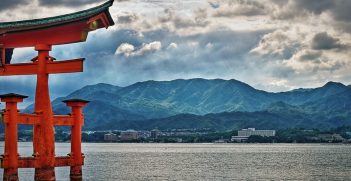Will the Quad Alliance Take Off?

The US has made clear that it wants to establish firmer strategic cooperation among Quad members. Achieving this may be difficult due to the economic incentives to remain on good terms with China.
On October 6, the Japan-US-Australia-India Quad Foreign Ministers Meeting was held in Tokyo. The Quadrilateral Security Dialogue, also known as “the Quad,” is an informal strategic forum, but it is key to the “Free and Open Indo-Pacific”concept. Officially, the Quad does not have an explicit “target,” but it is clear that it aims to put pressure on China. The four countries share common democratic values and are concerned about China’s security strategy.
In the meeting, US Secretary of State Mike Pompeo accused the Chinese Communist Party (CCP) of exploitation, and US Deputy Secretary of State Stephen Biegun argued for the establishment of a NATO-like alliance with India, Japan, and Australia. Naturally, China strongly criticised this “anti-China meeting.” China’s foreign minister, Wang Yi, said the Quad is “part of Washington’s effort to build an ‘Indo-Pacific NATO’.” China is afraid that the Quad will establish “anti-China security cooperation” in Indo-Pacific and inhibit the People’s Liberation Army (PLA) mission to “safeguard maritime rights and interests.”
However, China’s role as a critical trading partner for each Quad country has become even more significant in light of the coronavirus recession. The US and Australia already face various economic conflicts with China. The US is engaged in a trade war with China, and Australia demanded an international inquiry about the origin of the coronavirus, to which China responded by imposing tariffs on barley and suspending the import of beef from Australia. Prime Minister Scott Morrison has said that Australia would not be intimidated by China’s actions.
The two counties have already started military counteraction vis-à-vis China’s military expansion. The US Department of Defense notes that China has the largest navy in the world. Accordingly, the US has plans to increase its naval power to 355 warships by 2030 to keep its sea superiority in Indo-Pacific. Australia also plans to invest about $270 billion to upgrade its defence capabilities, including new Hunter class frigates and attack-class submarines, according to the 2020 Defence Strategic Update.
Until recently, India had kept a neutral position toward the US and China, which provided India strategic value as a balancer. In 2018, Prime Minister Narendra Modi announced the concept of a “free, open, ‘inclusive’ Indo-Pacific policy (FOIIP)” as India’s strategy for the region. The FOIIP aims not to exclude China but to pursue progress and prosperity with all nations. However, it appears that the recent China-India border skirmish has changed India’s national policy. Since it broke out, India has released a series of new policies targeted at China. Currently, India bans more than 1000 apps linked to China, including WeChat and TikTok.
India’s new strategy may hinder its strategic value because it signals the end of India’s role as a balancer. However, India’s stance has made China disperse its military capability from the East China Sea to the Indian Ocean through the so-called “String of Pearls.”
Compared with other Quad members, Japan’s policy appears relatively moderate, despite being one of the nations most affected by China’s maritime expansion. The PLA has been very active for several years in the East China Sea. In the last fiscal year, Japanese Air Self-Defense Force fighters were scrambled 675 times after Chinese planes. In response, Japan’s Ministry of Defense has requested an increase of 3.3 percent to in budget, to about ¥5.49 trillion, which is its largest budget ever though it still remains at less than one percent of GDP. Japan’s new prime minister, Suga Yoshihide, expressed opposition to establishing an “Asian-NATO” on 20 October. One of the main reason is importance of China’s market to Japan. For example, even through the coronavirus pandemic, new sales of Japanese cars in China have increased over the previous year.
Japan is taking action to reduce economic dependence on China. Tokyo has spent about ¥12 billion to support Japanese companies looking to exit China after the coronavirus, and has set aside a total of ¥30 billion for this campaign. However, it is true that Japan will need to continue trading with China to recover from the recession. Japanese exports to China from January to September 2020 were 14 percent more than the previous year. Therefore, Japan is likely to continue its economic cooperation with China with limited reinforcement of its military capability.
Following China’s recent “Wolf Warrior” diplomacy and the China-India skirmish in May, bilateral and trilateral cooperation among the Quad has accelerated. In June, India and Australia agreed to strengthen security cooperation. In September, Japan, India, and Australia agreed to achieve supply chain resilience in the Indo-Pacific region.
India officially invited Australia to join Exercise MALABAR 2020, which Australia accepted. Exercise MALABAR is a trilateral naval exercise involving Japan, the US, and India. Exercise MALABAR 2007, then a bilateral exercise between the US and India, was held along with Japan, Australia, and Singapore for the first time, provoking a strong reaction from China. In response, Australia moved away from the exercise. Exercise MALABAR 2020 symbolises a new stage of the Quad, one that acknowledges China’s objection and signals a willingness to engage in concrete, visible cooperation to balance China.
The US preference is to develop the current Quad arrangement into an expanded anti-China coalition. Stephen Biegun said the arrangement “could be opened to other countries that support a free and open Indo-Pacific region.” New Zealand, South Korea, and Vietnam are potential members for the “Quad Plus.” However, their inclusion would bring more difficulties, mainly because these countries depend on the Chinese market to a greater extent than current Quad members, and thus they would be more vulnerable to trade sanctions if they did join. This has occurred before — China imposed economic sanctions on South Korea because of the deployment of the Terminal High Altitude Area Defense system in 2017. South Korean Foreign Minister Kang Kyung-wha noted, in reference to the Quad, that it is not a good idea to shut out other countries.
At present, the US-China political struggle remains in its prologue. Amid sharpening US-China competition, the Quad foreign ministers meeting in October and Exercise MALABAR 2020 will serve as a starting point for a new pact in the Indo-Pacific. However, stronger strategic cooperation among Quad members may mean the arrival of a new Cold War in the region.
Tsuyoshi Minami is a postdoctoral fellow at the College of Humanities and Communications, Shanghai Normal University. He specialises in international relations in the Asia-Pacific region, especially China’s security policy. Currently, he focuses on China’s maritime strategy.
This article is published under a Creative Commons Licence and may be republished with attribution.





